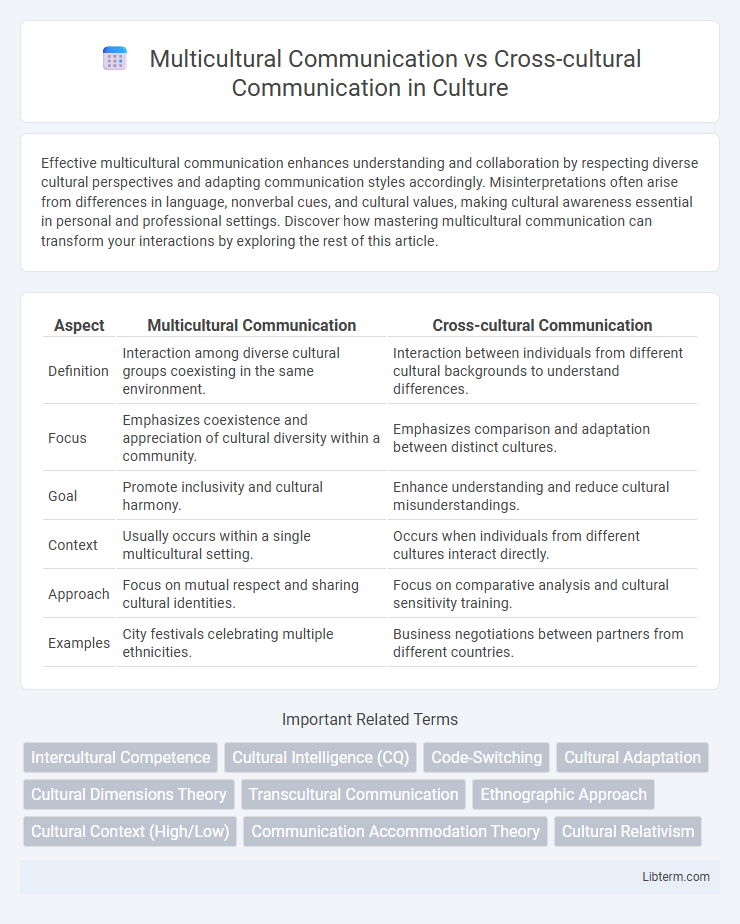Effective multicultural communication enhances understanding and collaboration by respecting diverse cultural perspectives and adapting communication styles accordingly. Misinterpretations often arise from differences in language, nonverbal cues, and cultural values, making cultural awareness essential in personal and professional settings. Discover how mastering multicultural communication can transform your interactions by exploring the rest of this article.
Table of Comparison
| Aspect | Multicultural Communication | Cross-cultural Communication |
|---|---|---|
| Definition | Interaction among diverse cultural groups coexisting in the same environment. | Interaction between individuals from different cultural backgrounds to understand differences. |
| Focus | Emphasizes coexistence and appreciation of cultural diversity within a community. | Emphasizes comparison and adaptation between distinct cultures. |
| Goal | Promote inclusivity and cultural harmony. | Enhance understanding and reduce cultural misunderstandings. |
| Context | Usually occurs within a single multicultural setting. | Occurs when individuals from different cultures interact directly. |
| Approach | Focus on mutual respect and sharing cultural identities. | Focus on comparative analysis and cultural sensitivity training. |
| Examples | City festivals celebrating multiple ethnicities. | Business negotiations between partners from different countries. |
Introduction to Multicultural and Cross-cultural Communication
Multicultural communication involves interactions among individuals from diverse cultural backgrounds within a single society, emphasizing understanding and respect for cultural differences. Cross-cultural communication compares communication styles and practices between two or more distinct cultures to identify similarities and differences. Both fields are essential for fostering effective dialogue in globalized environments, with multicultural communication focusing on coexistence and cross-cultural communication on comparative analysis.
Defining Multicultural Communication
Multicultural communication refers to the exchange of information between individuals from multiple cultural backgrounds within a single environment, emphasizing understanding and respect for cultural diversity. It involves navigating various cultural norms, values, languages, and communication styles to foster inclusive interactions. This contrasts with cross-cultural communication, which typically analyzes communication between two or more distinct cultures to identify differences and similarities.
Understanding Cross-cultural Communication
Understanding cross-cultural communication involves recognizing and adapting to differences in language, customs, and social norms between distinct cultural groups. It requires active listening, empathy, and awareness of cultural biases to prevent misunderstandings in international business, education, and diplomacy. Effective cross-cultural communication enhances collaboration and fosters mutual respect among diverse populations.
Key Differences between Multicultural and Cross-cultural Communication
Multicultural communication involves interactions among individuals from multiple cultural backgrounds within a single setting, emphasizing the coexistence and dynamic exchange of diverse cultural perspectives. Cross-cultural communication, by contrast, focuses on comparing and contrasting communication styles and norms between two or more distinct cultures to understand differences and improve intercultural understanding. Key differences lie in scope and approach: multicultural communication addresses simultaneous cultural diversity, while cross-cultural communication analyzes cultural contrasts to bridge communication gaps.
Importance of Multicultural Communication in Globalization
Multicultural communication is essential in globalization as it facilitates effective interaction among individuals from diverse cultural backgrounds, enhancing cooperation and reducing misunderstandings in international business and diplomacy. Unlike cross-cultural communication, which compares different cultures, multicultural communication integrates multiple cultures simultaneously, promoting inclusivity and fostering innovation in global teams. Embracing multicultural communication skills improves organizational performance and supports cultural sensitivity, critical for success in an interconnected global economy.
Challenges in Cross-cultural Communication
Cross-cultural communication faces challenges such as language barriers, differing cultural norms, and varying communication styles, which often lead to misunderstandings and misinterpretations. Emotional expressions and nonverbal cues can differ significantly between cultures, complicating effective interaction. Overcoming these challenges requires cultural awareness, empathy, and adaptability to ensure clear and respectful communication across diverse cultural contexts.
Strategies for Effective Multicultural Interaction
Effective multicultural communication strategies emphasize cultural awareness, active listening, and empathy to navigate diverse cultural norms and values. Utilizing adaptive communication techniques, such as contextual sensitivity and nonverbal cue interpretation, enhances mutual understanding and reduces potential misunderstandings. Implementing inclusive language and encouraging open dialogue fosters trust and collaboration in multicultural interactions.
Overcoming Barriers in Cross-cultural Communication
Overcoming barriers in cross-cultural communication requires understanding diverse cultural norms, values, and communication styles to avoid misunderstandings and conflicts. Effective strategies include active listening, cultural empathy, and the use of clear, simple language to bridge gaps between different cultural backgrounds. Training in intercultural competence enhances the ability to navigate these barriers, fostering more successful interactions in global business and social contexts.
Real-world Examples of Multicultural vs Cross-cultural Communication
Multicultural communication occurs within a single context where multiple cultural groups interact, such as a diverse workplace in New York City where employees from various ethnic backgrounds collaborate daily. Cross-cultural communication involves exchanges between people from different cultures aiming to understand and bridge cultural differences, exemplified by international business negotiations between Japanese and German companies. Real-world examples highlight multicultural communication in multicultural classrooms fostering inclusion, while cross-cultural communication is critical in diplomatic relations requiring cultural sensitivity for successful agreements.
Future Trends in Intercultural Communication
Multicultural communication emphasizes interactions within diverse cultural groups coexisting in the same environment, while cross-cultural communication focuses on comparing and contrasting different cultures to enhance understanding. Future trends in intercultural communication will increasingly rely on artificial intelligence and virtual reality to simulate immersive cultural experiences, breaking down language barriers and fostering global collaboration. Enhanced digital platforms and real-time translation tools are projected to revolutionize how individuals and organizations navigate cultural nuances in international contexts.
Multicultural Communication Infographic

 libterm.com
libterm.com